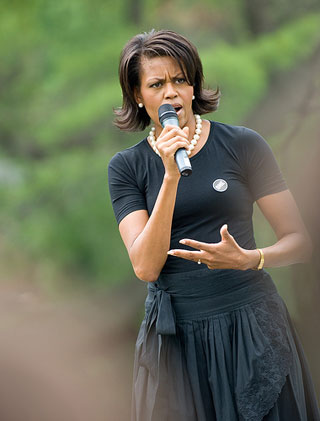The Transformation of Michelle Obama
by Mary Hess
Image, they say, is everything. New York’s senator, Hillary Clinton, struggles to overcome the perception that she is a power-hungry, vengeful woman whose proximity to power has brought her close to being the first female presidential nominee of a major political party.

Now another woman from Illinois, Michelle Obama, may well become First Lady: Her professional success, rising from very modest blue-collar origins to the Ivy League, matters less to us than her race and her persona as wife and mother. Is America ready for a black president? Possibly, but the focus in recent days inevitably turned to Barack Obama’s spouse and her public image. Some say Michelle Obama is “too black” or “too street.” Hillary and Michelle are both commodified and reduced to formulas according to our inclination. Pundits may dwell on wardrobes and gossip about these women, but in their respective speeches at the Democratic National Convention, they evoked history, both their own and that of the ongoing story of women in America. Hillary Clinton reminded us of New York’s powerful legacy, of the Seneca Falls Women’s Rights Convention, Rochester’s Susan B. Anthony, and Auburn’s Harriet Tubman.
Both Clinton and Obama have made history, but the emergence of a strong, confident Michelle Obama as a public figure is potentially more significant than even Hillary Clinton’s achievement. Suffrage and abolition were the great causes of the past, and white and black women were united, often uneasily, in the fight for justice. Who knows, for example, of Ida Wells-Barnett, born in 1862, the crusading journalist who exposed the horrors of lynching? As a young black woman, she not only raised her orphaned siblings alone but established her own press. Her life was threatened many times, and yet she refused to be intimidated by racism or sexism. She was also a wife and mother, and with her husband, Ferdinand Barnett, published the Chicago Defender, one of the most influential black newspapers. Ida Wells-Barnett was often criticized for being too assertive, too outspoken—Susan B. Anthony, a close friend and ally, opposed her marriage because she felt it took her away from the cause, calling it “a divided duty.” Ida Wells-Barnett was a woman ahead of her time, and her challenges would be familiar to any woman today, and certainly to Michelle Obama and Hillary Clinton.
Black women, however, face a separate, and more difficult obstacle: All too often, their lives are reduced in significance because of their race. In 1884, Wells-Barnett was thrown off a train for daring to sit in a car reserved for whites. She sued the railroad, won, and then suffered the further indignity of a reversal. When Michelle Obama spoke of the March on Washington in 1963, which happened 45 years ago this week, images of Martin Luther King’s ringing call to the nation’s conscience underscored the importance of the moment. But few know of another event that played out on August 28, 1963. On that day, William Zantzinger, a wealthy and well-connected young white farmer from Baltimore, received a six-month sentence for manslaughter. His crime? Causing the death of a 51 year-old black grandmother, Hattie Carroll, an event which would have gone unnoticed by most if Bob Dylan, then just emerging as a “protest” singer, hadn’t written a moving, elegaic ballad, “The Lonesome Death of Hattie Carroll.” Justice was not served that day, and America has never really come to terms with the Civil Rights movement, particularly the role of black women. Violence against blacks was commonplace in 1963, and Hattie Carroll, a barmaid at the annual Spinster’s Ball, died because of a blow inflicted by an intoxicated Zantzinger, who was angry at her perceived slowness in getting him yet another drink. A proud and loving mother of nine children, a valued member of her church, Hattie Carroll was much more than a statistic. She was more than than the image Bob Dylan created.
We all think we know our history, we repeat what is most comfortable for us—the story of Rosa Parks is transformed from the story of a career activist trained in nonviolence into a fable about a woman whose protest was accidental, a seamstress “too tired” to get up from her seat on a Montgomery bus.
We must examine our need to create these shallow images that do not truly reflect the women who are making history and inspiring our daughters to seek the equality which is still not ours. Appreciating Michelle Obama should go beyond her elegance and her winning little girls—yes, isn’t she lovely, but what is she saying to us? Both Clinton and Obama are important to all American women, and should prompt us to examine our history more realistically, being fair to all and rejecting hagiography and stereotyping. Legend is alluring, but truth is tranformative.
—mary hess
Artvoice reserves the right to edit letters for content and length. Shorter letters have a better chance at being published in their entirety. Please include your name, hometown, and contact number. Email letters to: editorial@artvoice.com or write to: Artvoice Letters, 810 Main Street, Buffalo, NY 14202
blog comments powered by Disqus
|
Issue Navigation> Issue Index > v7n37: In The Aftermath (9/11/08) > The Transformation of Michelle Obama This Week's Issue • Artvoice Daily • Artvoice TV • Events Calendar • Classifieds |









 Current Issue
Current Issue